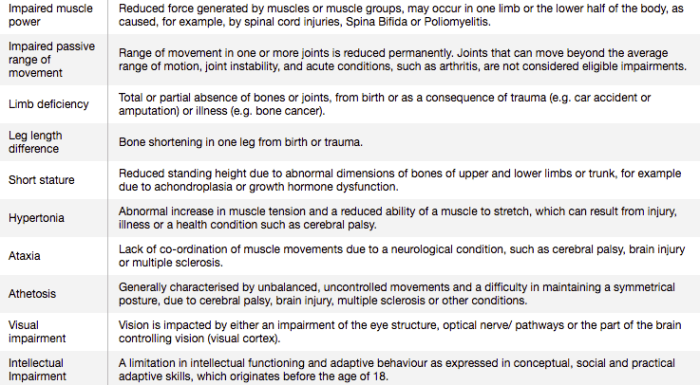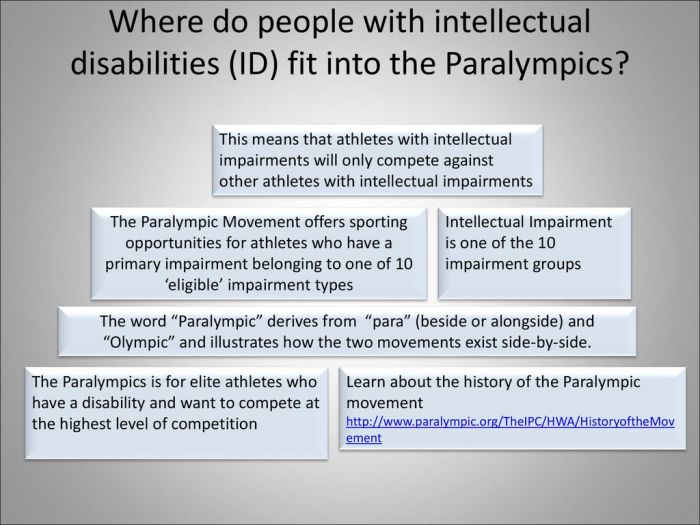What does S14 mean in Paralympics? This classification, a crucial component of the Paralympic movement, ensures fair competition among athletes with a wide range of impairments. The S14 classification, specifically, designates athletes with intellectual impairments, allowing them to compete on a level playing field.
The Paralympic classification system is a complex yet essential framework that categorizes athletes based on their functional abilities. It takes into account various factors, including the type and severity of impairment, as well as the athlete’s ability to perform specific sporting tasks.
This system is designed to minimize the impact of impairment on athletic performance and ensure that competition remains fair and equitable.
Understanding the Paralympic Classification System: What Does S14 Mean In Paralympics

The Paralympic classification system is a crucial aspect of the Paralympic Games, ensuring fair competition among athletes with a wide range of impairments. It is a complex and nuanced system designed to create a level playing field for athletes with diverse abilities.
The Purpose of Paralympic Classification
The Paralympic classification system aims to group athletes with similar functional abilities, regardless of their specific impairment. This system is designed to:
- Ensure fair competition by minimizing the impact of impairments on athletic performance.
- Promote inclusivity and participation by creating categories that cater to the unique needs of athletes with different impairments.
- Foster respect and understanding for the diversity of human abilities.
Different Impairment Groups in the Paralympics
The Paralympic classification system categorizes athletes based on ten impairment groups:
- Amputee:Athletes missing a limb or part of a limb.
- Cerebral Palsy:Athletes with a disorder affecting muscle coordination, movement, and posture.
- Les Autres:Athletes with impairments not classified in other groups, such as dwarfism, muscular dystrophy, or spina bifida.
- Visual Impairment:Athletes with varying degrees of vision loss.
- Intellectual Impairment:Athletes with intellectual disabilities.
- Wheelchair:Athletes who use a wheelchair for mobility.
- Dwarfism:Athletes with a condition causing disproportionate growth.
- Spinal Cord Injury:Athletes with injuries to the spinal cord.
- Muscular Dystrophy:Athletes with a group of genetic diseases that cause muscle weakness and degeneration.
- Multiple Sclerosis:Athletes with a disease affecting the central nervous system.
Examples of Fair Competition
The Paralympic classification system ensures fair competition by:
- Adjusting competition rules:For example, in wheelchair tennis, athletes may be classified based on their ability to maneuver the wheelchair, allowing for a more even playing field.
- Creating specific categories:Athletes in wheelchair basketball are classified based on their functional ability, ensuring that teams have a balanced mix of players with different skills.
- Allowing for adjustments in equipment:Athletes with visual impairments may use specialized equipment, such as guide runners in athletics or a sighted guide in swimming, to level the playing field.
What S14 Represents

The S14 classification in Paralympic sports is a specific category for athletes with intellectual impairments. It represents a group of individuals who demonstrate significant limitations in cognitive functioning, impacting their ability to learn, solve problems, and adapt to new situations.
This classification ensures fair competition by grouping athletes with similar functional limitations together.
Functional Limitations in S14
The S14 classification is defined by specific functional limitations related to cognitive abilities. Athletes classified as S14 typically exhibit:
- Significant difficulties in learning and understanding new information.
- Challenges in problem-solving and decision-making.
- Reduced capacity for abstract thinking and generalization.
- Impairments in memory and attention span.
- Difficulties in adapting to changing environments or unexpected situations.
These limitations may impact an athlete’s performance in various aspects of a sport, such as strategy, tactics, and reaction time. The classification system aims to account for these differences and create a level playing field for all athletes.
Sports Where S14 Athletes Compete
Athletes classified as S14 compete in a range of sports, including:
- Swimming: Athletes compete in various strokes and distances, demonstrating their strength, endurance, and technique.
- Athletics: Athletes participate in events such as sprints, middle-distance races, long jump, and shot put, showcasing their speed, power, and coordination.
- Badminton: Athletes engage in singles and doubles matches, requiring agility, strategy, and precision.
- Table Tennis: Athletes compete in singles and doubles matches, demonstrating their hand-eye coordination, speed, and tactics.
These are just a few examples of sports where S14 athletes compete. Their participation in these sports highlights their dedication, resilience, and determination in overcoming their functional limitations.
S14 Athletes in Different Sports

S14 athletes compete in a wide range of Paralympic sports, demonstrating exceptional athleticism and resilience. Their participation showcases the diversity of abilities within the Paralympic movement and inspires athletes and spectators alike. Understanding the specific challenges and training methods employed by S14 athletes in different sports provides valuable insights into their unique journeys.
In the Paralympic Games, S14 represents a classification for swimmers with intellectual impairments. While the world of sports focuses on these athletes’ determination, the gaming world is abuzz with anticipation for the release of black myth wukong ps5 disc , a highly anticipated action RPG.
Back to the Paralympics, the S14 classification highlights the diverse range of abilities showcased in these incredible events.
S14 Athletes in Various Sports, What does s14 mean in paralympics
S14 athletes compete in a variety of Paralympic sports, showcasing their athleticism and determination. Here is a table outlining some notable sports, events, athletes, and key skills required:
| Sport | S14 Event | Notable S14 Athletes | Key Skills Required |
|---|---|---|---|
| Swimming | 50m Freestyle, 100m Freestyle, 200m Freestyle, 100m Backstroke, 100m Breaststroke, 100m Butterfly, 200m Individual Medley | Bethany Firth (Great Britain), Matthew Cowdrey (Great Britain), Toni Shaw (Australia) | Strength, endurance, technique, speed |
| Athletics | 100m, 200m, 400m, 800m, 1500m, Long Jump, Shot Put | Breanna Clark (United States), Sophie Hahn (Great Britain), Jonathan Broom-Edwards (Great Britain) | Speed, power, agility, coordination |
| Table Tennis | Singles, Doubles | Will Bayley (Great Britain), Florian Van Acker (Belgium), Alena Kanova (Czech Republic) | Hand-eye coordination, reaction time, strategy, mental focus |
| Badminton | Singles, Doubles | Leani Ratri Oktila (Indonesia), Frederic Corder (France), Lucas Mazur (France) | Speed, agility, power, tactical awareness |
Challenges Faced by S14 Athletes
S14 athletes face unique challenges in their respective sports. For instance, swimmers with intellectual impairments may require additional support with understanding and executing complex stroke techniques. Athletes in sports like athletics may need to adapt their training regimens to accommodate their specific needs, focusing on developing core strength and balance.
Training Methods for S14 Athletes
Training methods for S14 athletes are tailored to their individual needs and the demands of their sport. Swimmers may emphasize drills that improve their stroke technique and water awareness, while athletes in sports like athletics may focus on strength and conditioning exercises that build power and endurance.
Coaches and trainers play a crucial role in supporting S14 athletes, providing personalized guidance and adapting training programs to ensure athletes can reach their full potential.
The Impact of S14 Classification on Competition
The S14 classification in the Paralympics plays a significant role in shaping the competitive landscape, ensuring fairness and inclusivity for athletes with intellectual impairments. This classification allows athletes with similar functional abilities to compete against each other, creating a level playing field and fostering a spirit of healthy rivalry.
The Role of Technology and Equipment
Technology and equipment play a crucial role in supporting S14 athletes, enabling them to compete at their best and achieve their full potential. These tools help bridge the gap between athletes with intellectual impairments and their counterparts without impairments, enhancing their performance and allowing them to participate effectively in various sports.
- Adaptive Equipment:Sports equipment specifically designed for S14 athletes, such as modified swimming suits, racing wheelchairs, and specialized prosthetics, are crucial in accommodating their individual needs and allowing them to participate effectively in their chosen sport. For example, in swimming, S14 athletes may use specialized suits that provide extra buoyancy or support, while in wheelchair racing, they may use wheelchairs with lighter frames or different wheel configurations to optimize their performance.
- Assistive Technology:Assistive technology, such as hearing aids, visual aids, and communication devices, can be instrumental in enhancing the performance of S14 athletes. For instance, hearing aids can help athletes with hearing impairments follow instructions and communicate effectively with coaches and officials.
Visual aids, such as specialized goggles or magnifying devices, can assist athletes with visual impairments in navigating the playing field or understanding the game.
Strategies Employed by S14 Athletes
S14 athletes often employ specific strategies to overcome their limitations and achieve success in their chosen sport. These strategies are tailored to their individual needs and abilities, allowing them to compete effectively against other athletes in their classification.
- Focus on Strengths:S14 athletes often focus on their strengths and develop strategies that capitalize on their unique abilities. For example, a swimmer with a cognitive impairment may focus on developing their speed and endurance, while a wheelchair racer with a physical impairment may focus on their agility and maneuvering skills.
- Adapting to Challenges:S14 athletes often adapt their training and competition strategies to accommodate their limitations. For instance, a swimmer with a visual impairment may use a sighted guide or a coach with specialized training to help them navigate the pool and maintain their position during the race.
A wheelchair racer with a cognitive impairment may use visual cues or specific signals from their coach to maintain focus and stay on track.
- Mental Resilience:S14 athletes often exhibit exceptional mental resilience, overcoming challenges and setbacks to achieve their goals. They may employ techniques such as visualization, positive self-talk, and mindfulness to maintain focus and motivation, even when facing adversity.
Inspiring Stories of S14 Athletes
The world of Paralympic sports is filled with remarkable individuals who overcome adversity and achieve extraordinary feats. Among them, S14 athletes stand out as inspiring examples of determination, resilience, and sheer talent. These athletes, classified for intellectual impairment, have faced unique challenges but have risen above them to excel on the global stage.
Stories of Triumph and Inspiration
The stories of S14 athletes are a testament to the power of human spirit. They showcase how individuals can embrace their differences and achieve greatness in the face of adversity.
- Bethany Firth, a British swimmer, has been a dominant force in the S14 category, winning multiple Paralympic medals and setting world records. Her journey has been marked by her dedication to the sport and her unwavering belief in herself. Despite facing initial doubts about her abilities, Firth’s determination and hard work have propelled her to the pinnacle of Paralympic swimming.
- Daniel Dias, a Brazilian swimmer, is another inspiring figure in the S14 category. Dias, who was born with a condition that affects his limbs, has overcome countless obstacles to become one of the most decorated Paralympians of all time. His remarkable achievements have earned him recognition as a symbol of hope and resilience for people with disabilities around the world.
- Alice Tai, a British swimmer, is a young athlete who has made a significant impact on the S14 category. Tai, who has a rare genetic condition that affects her movement, has broken numerous world records and won multiple Paralympic medals. Her story is a reminder that age is no barrier to achieving greatness in Paralympic sports.